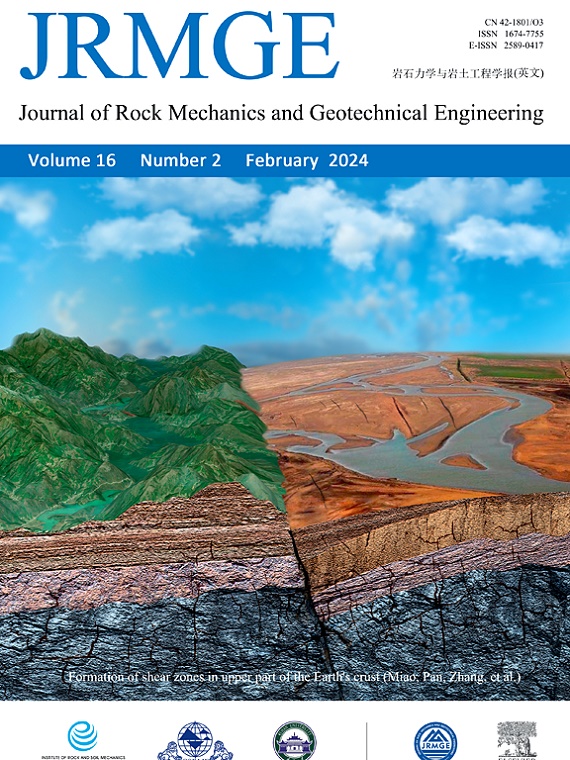On the calibration of a shear stress criterion for rock joints to represent the full stress-strain profile
IF 10.2
1区 工程技术
Q1 ENGINEERING, GEOLOGICAL
Journal of Rock Mechanics and Geotechnical Engineering
Pub Date : 2023-11-01
DOI:10.1016/j.jrmge.2023.07.019
引用次数: 0
Abstract
Conventional numerical solutions developed to describe the geomechanical behavior of rock interfaces subjected to differential load emphasize peak and residual shear strengths. The detailed analysis of pre- and post-peak shear stress-displacement behavior is central to various time-dependent and dynamic rock mechanic problems such as rockbursts and structural instabilities in highly stressed conditions. The complete stress-displacement surface (CSDS) model was developed to describe analytically the pre- and post-peak behavior of rock interfaces under differential loads. Original formulations of the CSDS model required extensive curve-fitting iterations which limited its practical applicability and transparent integration into engineering tools. The present work proposes modifications to the CSDS model aimed at developing a comprehensive and modern calibration protocol to describe the complete shear stress-displacement behavior of rock interfaces under differential loads. The proposed update to the CSDS model incorporates the concept of mobilized shear strength to enhance the post-peak formulations. Barton's concepts of joint roughness coefficient (JRC) and joint compressive strength (JCS) are incorporated to facilitate empirical estimations for peak shear stress and normal closure relations. Triaxial/uniaxial compression test and direct shear test results are used to validate the updated model and exemplify the proposed calibration method. The results illustrate that the revised model successfully predicts the post-peak and complete axial stress–strain and shear stress–displacement curves for rock joints.关于岩石节理的剪应力准则的校正,以表示完整的应力-应变剖面
传统的数值解用于描述受差荷载作用下岩石界面的地质力学行为,强调峰值和残余剪切强度。峰前和峰后剪应力-位移行为的详细分析是各种时变和动态岩石力学问题的核心,例如在高应力条件下的岩爆和结构不稳定。建立了完全应力-位移面(CSDS)模型,分析描述了岩石界面在差荷载作用下的峰前和峰后特性。CSDS模型的原始公式需要大量的曲线拟合迭代,这限制了其实际适用性和与工程工具的透明集成。本工作提出了对CSDS模型的修改,旨在开发一个全面和现代的校准协议,以描述不同载荷下岩石界面的完整剪切应力-位移行为。对CSDS模型的建议更新纳入了动员抗剪强度的概念,以增强峰后公式。结合Barton的节理粗糙系数(JRC)和节理抗压强度(JCS)概念,便于峰值剪应力和法向闭合关系的经验估计。三轴/单轴压缩试验和直剪试验结果验证了更新的模型,并举例说明了所提出的校准方法。结果表明,修正后的模型成功地预测了节理峰后和完整的轴向应力-应变曲线和剪切应力-位移曲线。
本文章由计算机程序翻译,如有差异,请以英文原文为准。
求助全文
约1分钟内获得全文
求助全文
来源期刊

Journal of Rock Mechanics and Geotechnical Engineering
Earth and Planetary Sciences-Geotechnical Engineering and Engineering Geology
CiteScore
11.60
自引率
6.80%
发文量
227
审稿时长
48 days
期刊介绍:
The Journal of Rock Mechanics and Geotechnical Engineering (JRMGE), overseen by the Institute of Rock and Soil Mechanics, Chinese Academy of Sciences, is dedicated to the latest advancements in rock mechanics and geotechnical engineering. It serves as a platform for global scholars to stay updated on developments in various related fields including soil mechanics, foundation engineering, civil engineering, mining engineering, hydraulic engineering, petroleum engineering, and engineering geology. With a focus on fostering international academic exchange, JRMGE acts as a conduit between theoretical advancements and practical applications. Topics covered include new theories, technologies, methods, experiences, in-situ and laboratory tests, developments, case studies, and timely reviews within the realm of rock mechanics and geotechnical engineering.
 求助内容:
求助内容: 应助结果提醒方式:
应助结果提醒方式:


